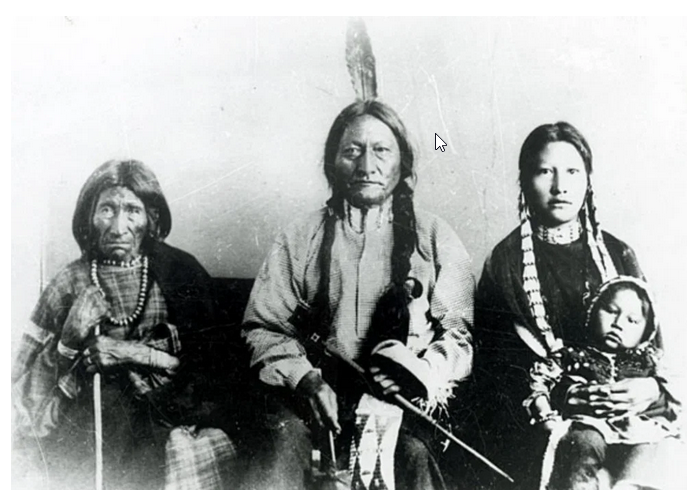A Foundation Of Blood

"In 1493, Pope Alexander VI issues a papal bull or decree, “Inter Caetera," in which he authorizes Spain and Portugal to colonize the Americas and its Native peoples as subjects. The decree asserts the rights of Spain and Portugal to colonize, convert, and enslave. It also justifies the enslavement of Africans." (Native Voices)
https://www.nlm.nih.gov/nativevoices/timeline/171.html#:~:text=Pope%20Alexander%20VI%20issues%20a,justifies%20the%20enslavement%20of%20Africans.
Talk on history of California Indians: https://www.youtube.com/embed/qUCCysmBOng
Jean-Francois de la Perouse (French explorer) on his expedition around the world in 1786, describes the ill treatment of natives by the ecclesiastical authorities, comparing the mission to a "plantation at Santo Domingo or any other West Indian island," noting the use of "irons and stocks," lashes of the whip, and the recourse to military authority to repossess any native converts who had chosen to return to their "relations in the independent villages.
Mr. Felipe de Neve, commander of the interior provinces of Mexico, a man replete with humanity and a Christian philosopher who died about four years ago, remonstrated against the practice [of corporal punishment]. He thought that the progress of the faith would be more rapid and the prayers of the Indians more agreeable to the Supreme Being if they were not constrained."
-
On January 7, 1831, California Governor Peter H. Burnett announced, “A war of extermination will continue to be waged between the races, until the Indian race becomes extinct.”’
-
Before that announcement, there was the coming of the miners and hunters, bringing the epidemics of the nineteenth century.
-
Even earlier, there was the establishment of twenty-one Spanish missions (between 1769 and 1833). Was this the beginning of the end?
The Mission Era was “first contact” between the native peoples of California and Europeans. Throughout this period, internal conflicts existed between the overly zealous Padre Junipero Serra, and the more cautious civil, military authorities (Captains Fages, Rivera and, finally, Felipe deNeve). Padre Serra’s desire to baptize more and more “heathens” was challenged by their concern for safety and caution.
Serra himself successfdully demanded the removal of Captains Fages and Rivera, earlier governors of "New Spain." Despitre Serra's repeaated atttempts, Captain Felipe de Neve proved a worthy and final adversary.
The odor of scorched gunpowder filled the air in the morning, it lay in soft, blue clouds over the earth of my people.
—Darryl Babe Wilson
This was the time when, with Spanish funds were drying up because of European wars, the Spanish were preparing to leave Alta California (or New Spain as the whole area was called then), retreating south to Mexico and Baja California.
What was to happen to the missions when the Spanish left? What was to happen to the native population (baptized “neophytes,” and non-baptized) living in the missions? They were ill-equipped to face the coming of the white man from the East. Serra and de Neve each had his answer, and those answers differed considerably from each other.

- 1850 Bloody Island Massacre: Nathaniel Lyon and his U. S. cavalry killed 100 Pomo people on Bo-no-po-ti island near Clear Lake, California, as they believed the natives had killed two local settlers who had been abusing and murdering members of the tribe. This incident led to a general outbreak of settler attacks against natives and a spike in mass killings all over Northern California.
- 1851 Old Shasta: Town miners killed 300 Wintu Indians near Old Shasta, California and burned down their tribal council meeting house.
- 1852 Bridge Gulch Massacre: 70 white men led by Trinity County Sheriff William H. Dixon killed more than 150 Wintu people in the Hayfork Valley of California, in retaliation for the killing of Col. John Anderson.

- 1852 Wright Massacre: White settlers led by the notorious Indian hunter Ben Wright massacred 41 Modocs during a “peace parley.”
- 1853 Howonquet Massacre: Californian settlers attacked and burned the Tolowa village of Howonquet, massacring 70 native people.
- 1853 Yontoket Massacre: A posse of settlers attacked and burned a Tolowarancheria at Yontocket, California, killing 450 Tolowa during a prayer ceremony.
- 1853 Achulet Massacre: White settlers launched an attack on a Tolowa village near Lake Earl in California, killing between 65 and 150 Indians at dawn.

- 1853 “Ox” incident: U.S. forces attacked and killed an unreported number of Indians in the Four Creeks area of Tulare County, California in what was referred to by officers as the “chastisement” of “our little difficulty.
- 1854 Nasomah Massacre: 40 white settlers attacked the sleeping village of the Nasomah Indians at the mouth of the Coquille River in Oregon, killing 15 men and one woman.
- 1854 Chetco River Massacre: Nine white settlers attacked a friendly Indian village on the Chetco River in Oregon, massacring 26 men and a few women. Most of the Indians were shot while trying to escape. Two Chetco who tried to resist with bows and arrows were burned alive in their houses. Shortly before the attack, the Chetco had been induced to give away their weapons as “friendly relations were firmly established.”

- 1854 Ward Massacre: Shoshone killed 18 of the 20 members of the Alexander Ward party, attacking them on the Oregon Trail. This event led the U.S. to eventually abandon Fort Boise and Fort Hall in favor of the use of military escorts for emigrant wagon trains.
- 1855 Klamath River Massacres: In retaliation for the murder of six settlers and the theft of some cattle, whites commenced a “war of extermination against the Indians” in Humboldt County, California.
- 1855 Lupton Massacre. A group of settlers and miners launched a night attack on an Indian village near Upper Table Rock, Oregon, killing 23 Indians—mostly elderly men, women, and children.
- 1855 Little Butte Creek: Oregon volunteers launched a dawn attack on a Tututniand Takelma camp on the Rogue River, where between 19 and 26 Indians were slaughtered.
